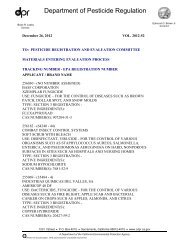Dichlorvos (DDVP) Risk Characterization Document - California ...
Dichlorvos (DDVP) Risk Characterization Document - California ...
Dichlorvos (DDVP) Risk Characterization Document - California ...
You also want an ePaper? Increase the reach of your titles
YUMPU automatically turns print PDFs into web optimized ePapers that Google loves.
Oral - Human<br />
One hundred and eight patients with infections were treated with <strong>DDVP</strong> in a granular-resin formulation<br />
as a broad-spectrum anthelmintic agent (Pena Chavarria et al., 1969). The patients were divided into<br />
2 groups: 24 subjects (14 males and 10 females) at the low dose of 6 mg/kg-day and 84 subjects (37<br />
males and 47 females) at the high dose of 12 mg/kg-day. The only clinical sign reported was brief<br />
mild headaches in a few subjects; no details were provided. Both plasma and erythrocyte ChE<br />
activities were inhibited to varying extent according to the data (presented in graphs). The<br />
significance of the data was difficult to determine as no raw data were presented, and the extent of the<br />
inhibition was presented in 25% intervals.<br />
Human subjects (6/group, average body weight of 81 kg) were fed <strong>DDVP</strong> (0.9 mg) in either gelatin<br />
salad or a premeal capsule containing cottonseed oil three times a day for 21 days (Boyer et al.,<br />
1977). No clinical signs or erythrocyte ChE inhibition were reported. Plasma ChE activity decreased<br />
continuously with dosing. After 21 days, the plasma ChE activities were about (estimated from graph)<br />
40% and 28% of pre-treatment activities for cottonseed and gelatin formulations, respectively. After<br />
termination of exposure, the plasma ChE activity returned to pre-treatment level and the half-life for<br />
the regeneration was calculated to be 13.7 days. The no-observed-adverse effect level (NOAEL) was<br />
reportedly 0.04 mg/kg-day for the calculation of Acceptable Daily Intake by WHO (1993).<br />
Special studies<br />
Additional studies for the consideration of acute toxicity are described in the III.C. SUBCHRONIC<br />
TOXICITY, III.G. DEVELOPMENTAL TOXICITY, and III.H. NEUROTOXICITY sections. The following<br />
are brief descriptions of the studies.<br />
<strong>DDVP</strong> (100% purity; 0 to 40 mg/kg) was administered to lactating rats by gavage every 2-4 days for 3<br />
weeks (Tracy et al., 1960). The adjusted dosages based on 3 days per week were 4.5, 9, 13, and 17<br />
mg/kg-day. Cholinergic signs of varying severity were observed 10 to 20 minutes after ingestion and<br />
included irritability, salivation, nasal twitching or scratching, sialorrhea, pronounced exophthalmus<br />
with excessive lacrimation, diarrhea, muscle fasciculation, violent tremors, convulsions, and death.<br />
The NOEL was 9 mg/kg-day.<br />
<strong>DDVP</strong> (0 to 21.0 mg/kg-day) was given to pregnant Sprague-Dawley rats by gavage once daily from<br />
gestational days 6 to 15 (Tyl et al., 1991a). Tremors were observed in the dams of the 21.0 mg/kgday<br />
group with onset within 10-60 minutes after each daily dosing. Other signs of toxicity included<br />
prone positioning, hindlimb splay, circling, vocalization, hypoactivity, labored respiration, ear shaking,<br />
and coprophagia. The NOEL was 3.0 mg/kg-day for cholinergic signs in the dams.<br />
Acute delayed neurotoxicity of <strong>DDVP</strong> was studied in atropinized chickens after oral administration of<br />
16.5 mg/kg <strong>DDVP</strong> on day 1 and again on day 22 (Beavers et al., 1988). At sacrifice on day 43, nerve<br />
fiber degeneration and axonal swelling were noted in one of 10 treated chickens.<br />
Two experiments were conducted in the Tunstall Laboratory with rabbits exposed to <strong>DDVP</strong> by<br />
inhalation. In the first experiment, female Dutch rabbits were exposed to <strong>DDVP</strong> by inhalation from day<br />
1 of mating<br />
18
















